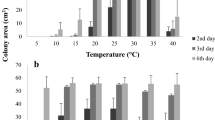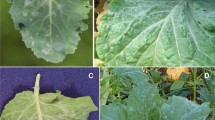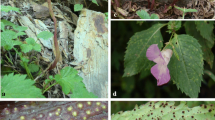Abstract
The fungus Stromatinia cepivora (Berk.) Whetzel, which causes white rot of cultivated Allium species, was assessed as a biological control agent for Angled Onion (Allium triquetrum L.), a widespread noxious invasive environmental weed in southern Australia. A. triquetrum showed relatively little genetic diversity, suggesting it was a suitable target for biological control. Genetic analysis of plants from 23 sites in the three main infested Australian states by internal transcribed spacer (ITS) and randomly amplified polymorphic DNA (RAPD) analysis suggested biotypes of A. triquetrum in Australia grouped by state, except for samples from Westernport Bay and Ararat (Victoria). Pathogenicity and virulence of two S. cepivora isolates were assessed on up to 13 A. triquetrum provenances, 6 cultivated Allium species and 9 Australian endemic monocotyledons in test-tube and pot trials. In test-tubes, sclerotia killed plants from all provenances. In pot trials with sclerotia and mycelium, the more pathogenic isolate killed plants from all but one provenance. No A. triquetrum provenance was resistant to S. cepivora, nor were common cultivated Allium species, but common Australian endemic monocotyledons from habitats infested with A. triquetrum showed no disease symptoms 90 days post-inoculation. S. cepivora thus has potential as a biological control agent for A. triquetrum in native bushland in Australia where the risk of it spreading to horticulturally important Allium species is low and can be controlled.







Similar content being viewed by others
References
Adams PB, Papavizas GC (1971) Effect of inoculum density of Sclerotium cepivorum and some soil environment factors on disease severity. Phytopathology 61:1253–1256
Agrios G (2005) Plant pathology, 5th edn. Elsevier Academic Press, San Diego
Australian Pesticides and Veterinary Medicines Authority (2013) Registered products, active constituents and chemical reviews. http://apvma.gov.au/products/index.php
Australia’s Virtual Herbarium (2008) Allium triquetrum. http://www.anbg.gov.au/avh/
Bansal RK, Broadhurst PG (1992) An evaluation of Allium germplasm for resistance to white rot caused by Sclerotium cepivorum Berk. N Z J Crop Hortic Sci 20:361–365
Bay of Plenty Regional Council (2012) Three cornered garlic. Onion weed. http://www.boprc.govt.nz/environment/pests/pest-plants-and-weeds/weed-index/grasses/three-cornered-garlic,-onion-weed/
Bayer Crop Science (2013) Folicur® 430 SC. Bayer Crop Science, Hawthorn East, Victoria. http://www.bayercropscience.com.au/resources/uploads/label/file7262.pdf
Blood K (2001) Environmental weeds: a field guide for SE Australia. Bloomings Book, Melbourne
Booer JR (1946) Further experiments on the control of white rot (Sclerotium cepivorum Berk.) in onion, shallots and leeks. Ann Appl Biol 33:413–419
Bruzzese E, Hasan S (1986) Host specificity of the rust Phragmidium violaceum, a potential biological control agent of European blackberry. Ann Appl Biol 108:585–596
Cahill DM, Rookes JE, Wilson BA, Gibson L, McDougall KL (2008) Phytophthora cinnamomi and Australia’s biodiversity: impacts, predictions and progress towards control. Aust J Bot 56:279–310
Cavan G, Potier V, Moss SR (2000) Genetic diversity of weeds growing in continuous wheat. Weed Res 40:301–310
Charles JG (2012) Assessing the non-target impacts of classical biological control agents: is host-testing always necessary? BioControl 57:619–626
Chase MW, Reveal JL, Fay MF (2009) A subfamilial classification for the expanded asparagalean families Amaryllidaceae, Asparagaceae and Xanthorrhoeaceae. Bot J Linn Soc 161:132–136
Coley-Smith JR (1960) Studies of the biology of Sclerotium cepivorum Berk IV. Germination of sclerotia. Ann Appl Biol 48:8–18
Coley-Smith JR (1979) Survival of pathogenic fungi in soil in the absence of host plants. In: Schippers B, Gams W (eds) Soil-borne plant pathogens. Academic Press, New York, pp 39–57
Coley-Smith JR (1986) A comparison of flavour and odour compounds of onion, leek, garlic and Allium fistulosum in relation to germination of sclerotia of Sclerotium cepivorum. Plant Pathol 35:370–376
Coley-Smith JR, Esler G (1983) Infection of cultivars of onion, leek, garlic and Allium fistulosum by Sclerotium cepivorum. Plant Path 32:373–376
Coley-Smith JR, Holt RW (1966) The effect of species of Allium on germination in soil of Sclerotium cepivorum Berk. Ann Appl Biol 58:273–278
Coley-Smith JR, King JE, Dickinson DJ, Holt RW (1967) Germination of sclerotia of Sclerotium cepivorum Berk. under aseptic conditions. Ann Appl Biol 60:109–115
Coley-Smith JR, Mitchell CM, Sansford CE (1990) Long-term survival of sclerotia of Sclerotium cepivorum. Plant Pathol 32:373–376
Crowe FJ (2008) White rot. In: Schwaetz JF (ed) Compendium of onion and garlic diseases and pests. APS Press, St. Paul, pp 22–26
Dal Santo P (2009) Onions. Strategic agricultural review process. Horticulture Australia. Downloaded from http://www.onionsaustralia.org.au/biosecurity-agrichemical/sarp.htm
Dixon RA (ed) (1985) Plant tissue culture: a practical approach. IRL Press, Oxford
Donald C, Porter I (2009) Integrated control of clubroot. J Plant Growth Regul 28:289–303
DPI (2008) Victorian Resources Online Invasiveness Assessment - Angled Onion (Allium triquetrum) in Victoria. http://www.dpi.vic.gov.au/dpi/vro/vrosite.nsf/pages/invasive_angled_onion
EPPO (European and Mediterranean Plant Protection Organization) (2011) Guidelines on pest risk analysis. http://archives.eppo.int/EPPOStandards/pra.htm?utm_source=archives.eppo.org&utm_medium=int_redirect
Esler G, Coley-Smith JR (1984) Resistance to Sclerotium cepivorum in Allium and other genera. Plant Pathol 33:199–204
Felsenstein J (1989) PHYLIP – Phylogeny Inference Package (Version 3.2). Cladistics 5:164–166
FRAC (Fungicide Resistance Action Committee) (2009) FRAC code list: Fungicide stored by mode of action (including FRAC code numbering). www.frac.info/frac/publication/anhang/FRAC_CODE_LIST.pdf
Gaskin JF, Bon M-C, Cock MJW, Cristofaro M, De Biase A, De Clerck-Floate R, Ellison CA, Hinz HL, Hufbauer RA, Julien MH, Sforza R (2011) Applying molecular-based approaches to classical biological control of weeds. Biol Control 58:1–21
Govaerts R, Kington S, Friesen N, Fritsch R, Snijman DA, Marcucci, R, Silverstone-Sopkin PA, Brullo S (2012) World checklist of selected plant families. Facilitated by the Royal Botanic Gardens. Kew. Search page: http://apps.kew.org/wcsp
Government of South Australia (2005) Infestation level of Allium triquetrum. http://www.pir.sa.gov.au/_media/pdf/pirsa_internet/biosecurity/nrm_biosecurity/pest_weed_policies/declared_plants_2/three_corner_garlic_policy.pdf
Hirschegger P, Jaske J, Trontelj P, Bohanec B (2010) Origins of Allium ampeloprasum horticultural groups and a molecular phylogeny of the section Allium (Allium; Alliaceae). Mol Phylogenet Evol 54:488–497
Hussey BMJ, Keighery GJ, Cousens RD, Dodd J, Lioyd SG (1997) Western weeds. A guide to the weeds of Western Australia. The Plant Protection Society of Western Australia (Inc.)
King JE, Coley-Smith JR (1969) Production of volatile alkyl sulphides by microbial degradation of synthetic alliin and alliin-like compounds, in relation to germination of sclerotia of Sclerotium cepivorum Berk. Ann Appl Biol 64:303–314
Morin L, Evans KJ (2012) Rubus fruticosus L. aggregate – European blackberry. In: Julien M, McFadyen R, Cullen J (eds) Biological control of weeds in Australia. CSIRO Publishing, Melbourne, pp 499–509
Morin L, Scott JK (2012) Asparagus asparagoides (L.) Druce – bridal creeper. In: Julien M, Cullen J, McFadyen R (eds) Biological control of weeds in Australia. CSIRO Publishing, Melbourne, pp 73–82
Muyt A (2001) Bush invaders of South-East Australia: a guide to the identification and control of environmental weeds found in South-East Australia. RG & FJ Richardson, Melbourne
Onions Australia (2013) Home page. http://www.onionsaustralia.org.au/index.htm
Parsons WT, Cuthbertson EG (1992) Noxious weeds of Australia. Inkata Press, Melbourne
Persson HA, Gustavsson BA (2001) The extent of clonality and genetic diversity in lingonberry (Vaccinium vitis-idaea L.) revealed by RAPDs and leaf-shape analysis. Mol Ecol 10:1385–1397
Pritchard GH (1996) Efficacy of herbicides against angled onion in pot trials. In: Shepherd RCH (ed), Proceedings of the 11th Australian Weeds Conference. Weed Science Society of Victoria. pp. 480–484
Rickards GK (1977) Prometaphase I and anaphase I in an interchange heterozygote of Allium triquetrum (Liliaceae). Chromosoma (Berl) 64:1–23
Snow R (1963) Alcoholic HCl-carmine as a stain for chromosomes in squash preparations. Stain Technol 38:9–13
Stevens PF (2013) Angiosperm phylogeny website. Version 13, 28 September 2013. Missouri Botanical Garden, St Louis, USA. http://www.mobot.org/MOBOT/research/APweb/
Taiz L, Zeigler E (2002) Plant physiology, 3rd edn. Sinauer Associates Inc., Sunderland
Tamura K, Dudley J, Nei M, Kumar S (2007) MEGA4: Molecular Evolutionary Genetics Analysis (MEGA) software version 4.0. Mol Biol Evol 24:1596–1599
TeBeest DO (1996) Biological control of weeds with plant pathogens and microbial pesticides. Adv Agron 56:115–137
Tehranchian P (2012) Biological control of an Australian noxious weed “Angled Onion” (Allium triquetrum L.) using molecular and traditional approaches. PhD Thesis, RMIT University, Melbourne
The International Plant Names Index (2012) Search page. http://www.ipni.org/
Thompson JD, Higgins DG, Gibson TJ (1994) Clustal W: improving the sensitivity of progressive multiple sequence alignment through sequence weighting, position-specific gap penalties and weight matrix choice. Nucleic Acids Res 122:4673–4680
van Wilgen BW, Moran VC, Hoffmann JH (2013) Some perspectives on the risks and benefits of biological control of invasive alien plants in the management of natural ecosystems. Environ Manag 52:531–540
White TJ, Bruns T, Lee S, Taylor J (1990) Amplification and direct sequencing of fungal ribosomal RNA genes for phylogenetics. In: Innis M, Gelfand D, Sninsky J, White T (eds) PCR protocols: a guide to methods and amplifications. Academic Press, San Diego, pp 315–322
Acknowledgments
The authors wish to thank Dr James Cunnington and Dr Oscar Villalta of the Department of Primary Industries (DPI) Victoria for the strains of S. cepivora used in these trials, and Dr Janet Anthony and Dr Siegy Krauss, Kings Park and Botanic Garden, Western Australia, for providing A. triquetrum bulbs from there. The authors also wish to thank Ross Field and David Lane, DPI Frankston, for information from a small trial conducted there in the past.
Author information
Authors and Affiliations
Corresponding author
Rights and permissions
About this article
Cite this article
Tehranchian, P., Adair, R.J. & Lawrie, A.C. Potential for biological control of the weed Angled Onion (Allium triquetrum) by the fungus Stromatinia cepivora in Australia. Australasian Plant Pathol. 43, 381–392 (2014). https://doi.org/10.1007/s13313-014-0279-6
Received:
Accepted:
Published:
Issue Date:
DOI: https://doi.org/10.1007/s13313-014-0279-6




